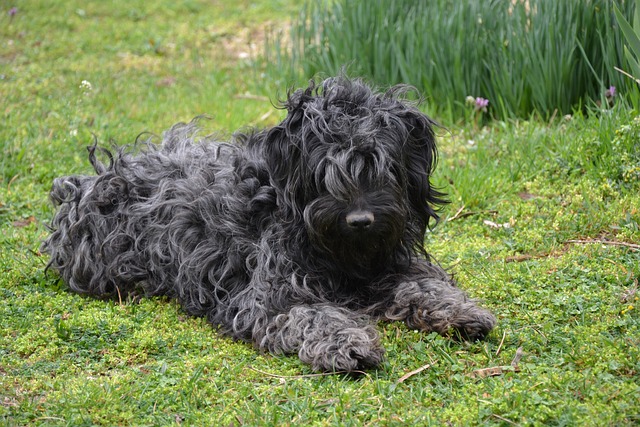


The Puli is a medium-sized herding dog known for its distinctive, corded coat and energetic personality. This ancient Hungarian breed is renowned for its intelligence, agility, and hardworking nature. The Puli was originally bred to herd livestock and protect flocks, and it continues to excel in various dog sports, particularly agility. The Puli is an affectionate and loyal companion that thrives in an active environment, making it a great choice for active families or individuals. Its unique appearance, with its long, thick, corded coat, makes the Puli one of the most recognizable herding breeds.
The Puli has a long and rich history that dates back over a thousand years. Originating in Hungary, the breed was developed to herd sheep and cattle in harsh, rugged terrain. The Puli's unique coat was an advantage in protecting it from the elements while working outdoors. The breed is believed to have been brought to Hungary by migrating tribes from Central Asia, where similar herding dogs were used. The Puli played a crucial role in Hungarian agriculture for centuries, and its herding instincts and protective nature made it an invaluable worker. The breed was first officially recognized in Hungary in the 18th century, and it gained international recognition in the 20th century. Today, the Puli remains a beloved companion and working dog, particularly in Europe and North America.
The Puli is a medium-sized dog, with males standing between 16 and 17 inches (41 to 43 cm) at the shoulder and females standing slightly shorter at 14 to 16 inches (36 to 41 cm). They typically weigh between 25 and 35 pounds (11 to 16 kg). The most distinctive feature of the Puli is its long, corded coat, which gives the dog its signature appearance. The coat, which consists of dense, water-resistant cords, requires regular maintenance and grooming to prevent matting. The Puli's coat can come in a variety of colors, including black, white, gray, and red, with the most common being black. The dog has a compact, athletic build, and its movement is swift and agile, making it well-suited for herding and other physically demanding tasks. The Puli has a wedge-shaped head with pointed ears, and its dark eyes convey an intelligent, alert expression.
The Puli is known for its intelligence, loyalty, and strong protective instincts. It is an alert and attentive dog, always aware of its surroundings. While the Puli is generally friendly and affectionate with its family, it can be reserved or cautious with strangers, making it an excellent watchdog. The breed is also known for being highly energetic, playful, and athletic, which makes it an ideal companion for active individuals or families. Pulis are highly trainable, but their independent nature means they may not always follow commands immediately, especially if they feel the task is unnecessary. They are often described as stubborn but eager to please their owners when properly motivated. Early socialization is important to ensure that the Puli grows up to be well-rounded and confident in various situations.
The Puli is a highly energetic and active breed with significant exercise needs. As a herding dog, it thrives in environments where it has ample space to run, play, and work. Daily physical activity is essential for maintaining the Puli's health and well-being. Long walks, runs, and playtime in a secure, fenced area are ideal for this breed. Pulis also excel in agility, obedience, and other dog sports, which provide excellent mental and physical stimulation. The breed enjoys tasks that challenge its intelligence, and it is happiest when it has a job to do, whether it’s herding, fetching, or participating in training exercises. Without sufficient exercise and mental stimulation, the Puli may become bored and engage in destructive behaviors.
The Puli is an intelligent and independent breed, which can make training both rewarding and challenging. While the Puli is highly trainable, it can be stubborn at times and may not always be eager to follow commands if it doesn’t see the purpose. Positive reinforcement methods, such as treats and praise, work best with this breed. The Puli enjoys training when it is engaging and fun, but it can become bored with repetitive tasks. Socialization is an important aspect of training, as the Puli can be reserved or aloof with strangers. Early exposure to different people, animals, and environments is essential for helping the Puli grow into a confident and well-mannered dog. Consistent, positive, and patient training will help the Puli develop its full potential as a well-behaved companion and working dog.
The Puli is generally a healthy breed, but like all dogs, it is prone to certain health issues. Common health concerns include hip dysplasia, progressive retinal atrophy (PRA), and certain heart conditions. Regular veterinary check-ups are essential to monitor the dog’s health and catch any potential issues early. One of the most significant aspects of caring for a Puli is grooming. The breed’s corded coat requires regular attention to prevent tangling and matting. It is recommended to wash and separate the cords regularly, and owners often have the coat professionally maintained to keep it in good condition. Pulis are relatively low-shedding, but their coat requires a significant amount of time and effort to keep clean and healthy. The Puli’s ears should be cleaned regularly to prevent infections, and its teeth should be brushed routinely to maintain dental health.
The Puli has an average lifespan of 12 to 16 years, which is typical for a dog of its size. With proper care, including a healthy diet, regular exercise, and routine veterinary visits, many Pulis live long, active lives. As they age, it is important to monitor their joint health and vision, as they may be prone to conditions like hip dysplasia and progressive retinal atrophy. Regular check-ups and early detection of potential health problems can help extend the Puli’s lifespan and ensure that it remains healthy and active throughout its life.
© copyright Dog Compendium 2024 - 2025